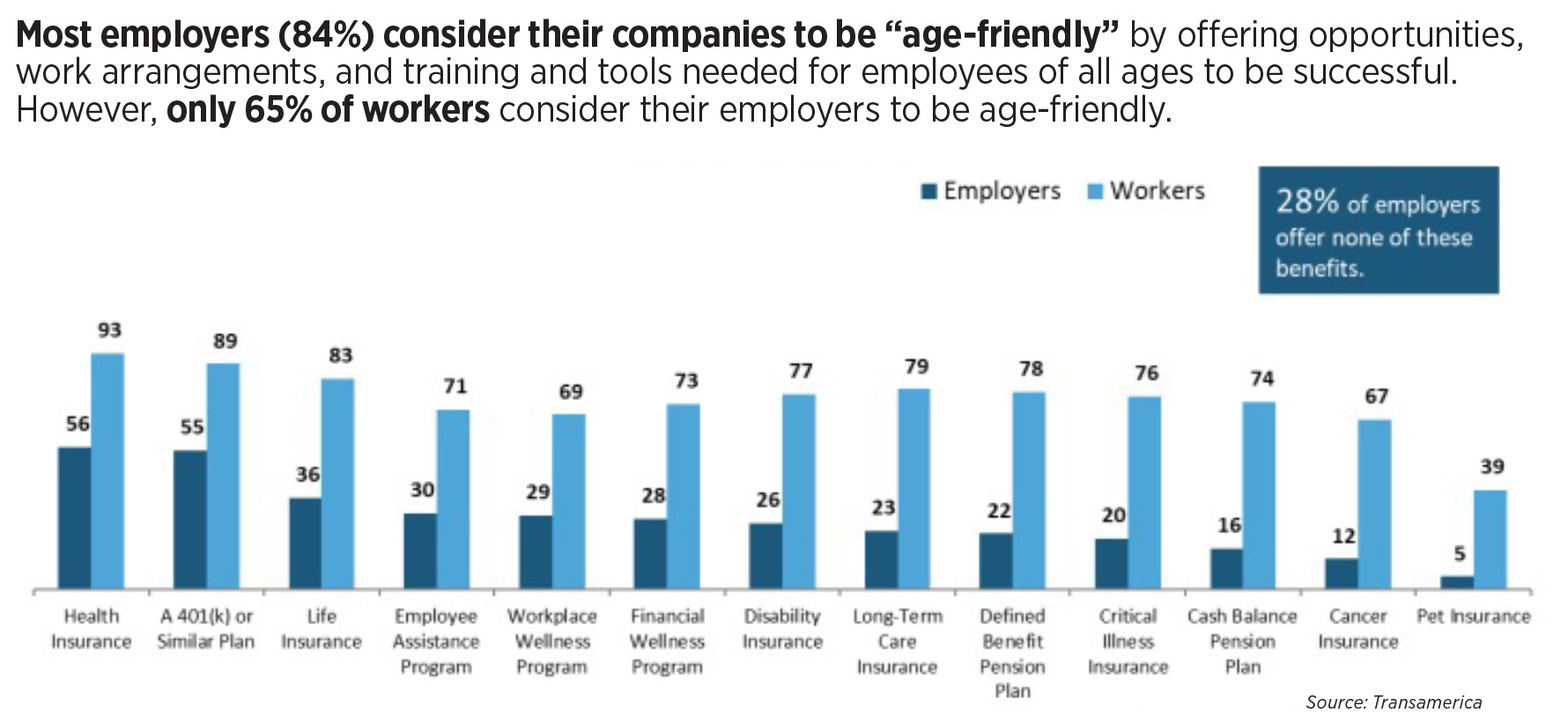Keeping five generations of workers happy with their benefits

Today’s workforce is multigenerational, with five different generations represented. They include the Silent Generation (those born before 1946), baby boomers (those born from 1946 to 1964), Generation X (those born from 1965 to 1980), millennials (those born from 1981 to 1996) and Generation Z (those born in 1997 and later). Each of these groups has their own specific needs when it comes to employee benefits and related financial services. But many employees do not believe their employers are meeting their needs.
A MetLife survey found that nearly two in every five employees believe that their benefits don’t adequately address their needs, 49% of employees said they would bear more of the cost to have access to more benefits that met their needs, and 70% of employees said they are more likely to remain with their employer if they are satisfied with their benefits. In light of the record number of employees leaving their jobs, this last statistic is particularly worth noting.
With the “great attrition” underway, it is especially important for employers and plan sponsors to gain essential information and insights on the challenges each generation faces and what benefits should be offered to better meet their life stage needs.
Navigating today’s multigenerational workforce landscape
Driven largely by the COVID-19 pandemic and the proliferation of new remote working, the great attrition, also referred to as the “great resignation,” has forced employers to consider how employees view their work-life balance, and what benefits and financial services they need to best achieve their goals.
In its latest research, McKinsey & Co. found that more than 50% of employee resignations stemmed from workplace stressors, including insufficient benefits, job insecurity, a toxic workplace culture or leadership, and financial stress. Forty percent of these same employees surveyed by McKinsey said that they were at least somewhat likely to leave their current job within the next three to six months.
Gallup’s “State of the Global Workplace: 2022 Report” supports the findings of employee discontent. Gallup reported that an estimated 25% admit to feeling miserable at work, while only 30% said they were thriving.
It’s also important for employers to understand that workers know what they want and need in terms of alleviating these pressures. For example, the findings from various organizations revealed that:
» 77% of working Americans consider retirement savings as their most important benefit. (Society for Human Resources Management)
» 51% of employees view company-
enforced limits on after-hours communications as beneficial to their mental health. (The Conference Board)
» Employees who are satisfied with their employers’ time and location flexibility are more than twice as likely to recommend their employer to job seekers. (LinkedIn)
Drilling down further, a survey of both 1,800 employers and their employees by the Transamerica Institute and its Transamerica Center for Retirement Studies uncovered significant gaps in what benefits employers offer and the importance employees attribute to those benefits. The survey found that:
» Life insurance is important to 83% of surveyed employees yet is offered by only 36% of employers.
» Employee assistance programs are important to 71% of employees but are offered by only 30% of employers.
» Workplace wellness programs are important to 69% of employees, but only 29% of employers offer them.
» 73% of employees said financial wellness programs were important to them, but only 28% of employers offered them.
The consequences of employees not having their needs effectively met are significant for employers. In addition to increased employee resignations, there is a direct correlation between corporate profits and workers’ contentment.
Organizations with unhappy workers have been found to earn nearly 25% less in profits than those with content employees. Productivity losses are attributed to high absenteeism among a company’s discontented workers. Work-related stress also has been shown to cost businesses billions of dollars in higher annual health care costs related to stress, associated illnesses and ensuing absenteeism.
In addition to these valuable findings, employers can gain even greater insight into what matters to their employees by looking at each generation’s distinct needs.
Meeting each generation’s needs
Before breaking down what matters most to each generation, these three principles should be understood. First, employee benefits should be personalized to individuals and not their generation.
To be sure that they are, employers should consider conducting their own survey to see what is important to their employees. Second, know that when it comes to employee benefits, the one-size-fits-all rule does not apply. And, finally, consider backing up specific benefits with essential support services such as financial literacy programs, on-site medical screenings, health and fitness seminars, and educational literature and videos explaining the various benefits.
Here is a breakdown of what is important to each generation, with percentages sourced from HUB International data.
The Silent Generation, representing 1% of the workforce.
With a focus on their retirement, members of this generation care most about staying healthy and injury-free, financing their long-term care needs, managing chronic illnesses (e.g., cardiovascular conditions, diabetes, chronic obstructive pulmonary disease, arthritis), and being able to meet their health care and prescription costs. They also want to remain relevant in the workforce as long as they continue working.
Employers should consider offering this generation injury prevention programs, seminars on chronic medical condition management, and opportunities to mentor younger staff members. These employees should be offered voluntary benefits such as critical illness, long-term care and hospital indemnity insurance; dental/vision insurance; estate planning services, including end-of-life planning; and identity theft protection.
Baby boomers, representing 27% of the workforce.
This “sandwich generation,” which often cares for elder parents as well as grandchildren, is also focused on their post-work quality of life and having adequate financial resources to cover their retirement expenses.
Baby boomers may be experiencing some health issues and therefore want certain medical benefits (e.g., critical illness, long-term care, hospital indemnity), prescription coverage and dental/vision coverage.
They also want support in terms of preventive health measures, health and fitness education, and programs that help them pay for their family responsibilities, such as access to 24/7 nurse helplines, seminars on elder care facilities and discounts on various health and fitness resources (e.g., gyms, nutritionists, healthy foods, vitamins). Retirement planning advice also is important to them.
Generation X, representing 27% of the workforce.
For Gen X, flexibility in their work schedule and work location, along with child care, financial security, education, and health and fitness support are top priorities. Additionally, they seek job security along with career advancement and professional development opportunities.
Unlike the preceding generations, Gen X wants tools to support their goals. They value on-demand digital tools that help them perform their tasks and wellness portals that offer access to health and fitness information. They appreciate on-site gyms equipped with the latest exercise equipment.
Financial education is also a high priority for Gen X; they recognize what they do not know in terms of financial planning and insurance requirements. Employers should offer this generation access to and education about life insurance because many Gen Xers admittedly do not understand life insurance or how much coverage they need. Accident insurance, disability insurance and dental/vision coverage for their families, as well as high-deductible health plans and health savings accounts, are valued. Other benefits to offer Gen X include financial wellness programs covering financial and dependent care planning.
Millennials, representing 44% of the workforce.
Having work that is meaningful is important to millennials. They also place a high value on a choice of benefits that support parental leave, scheduling and workplace flexibility, and workplace experiences that are engaging and purposeful. Like Generation X, millennials also value digital and online tools for wellness, social engagement and support; wellness programs and challenges that help them stay motivated and meet their health and fitness goals; volunteer opportunities that support their mission-driven goals; and mental health support programs.
Millennials also need and want financial education and resources to address their financial planning needs and student loan repayment. Life insurance, health and disability insurance, accident and hospital indemnity insurance (in particular, to cover maternity expenses), and dental/vision coverage are highly valued.
Generation Z, representing 1% of the workforce.
Of all the generations, Gen Z is perhaps the most focused on professional and personal growth.
They regard career advancement as one of their most important criteria when looking for a job.
Employers looking to attract members of this generation should note that a collaborative work environment and a flexible work culture are important to them. Time and stress management tools, mental health support, digital wellness tools, volunteer opportunities, and opportunities for them to share their technology skills with their co-workers are also important to them. Benefits that appeal to this generation include accident insurance, student loan assistance and financial planning education. Since many members of Gen Z have health insurance coverage under their parents, this is not a top priority for them, although medical insurance education should be offered.
Regardless of the generation, there are some benefits that all employees regard as important. They include paid time off, financial assistance, 401(k) and retirement planning, and work-life balance.
When planning employee benefits, employers and plan sponsors should consider what is important to their employees along with the budget they have for employer-paid benefits. Employers also should consider what voluntary benefits they should offer.
Benefits brokers should help employers perform due diligence when selecting benefits and then help employers create a communications plan to convey these benefits in the simplest, easiest-to-understand terms, avoiding industry jargon. Place benefit information on employee portals where it can be accessed on a 24-hour/365-day basis from any device.
Following these guidelines and understanding of today’s multigenerational workforce, employers can better retain and attract high-quality employees who will contribute to an organization’s overall success, profitability and long-term viability.
John Thornton is executive vice president, sales and marketing, Amalgamated Life Insurance Company. He may be contacted at [email protected].







Financial literacy is contagious
Volunteering for success — with Jeff Chernoff
Advisor News
- Most Americans optimistic about a financial ‘resolution rebound’ in 2026
- Mitigating recession-based client anxiety
- Terri Kallsen begins board chair role at CFP Board
- Advisors underestimate demand for steady, guaranteed income, survey shows
- D.C. Digest: 'One Big Beautiful Bill' rebranded 'Working Families Tax Cut'
More Advisor NewsAnnuity News
- MetLife Declares First Quarter 2026 Common Stock Dividend
- Using annuities as a legacy tool: The ROP feature
- Jackson Financial Inc. and TPG Inc. Announce Long-Term Strategic Partnership
- An Application for the Trademark “EMPOWER PERSONAL WEALTH” Has Been Filed by Great-West Life & Annuity Insurance Company: Great-West Life & Annuity Insurance Company
- Talcott Financial Group Launches Three New Fixed Annuity Products to Meet Growing Retail Demand for Secure Retirement Income
More Annuity NewsHealth/Employee Benefits News
- CT set aside $120 million to help cover residents’ health insurance costs. How to get help
- ARE SLEEP STUDIES COVERED BY INSURANCE?
- ACADEMYHEALTH'S SITUATION REPORT: CRITICAL POLICY DEVELOPMENTS WE'RE WATCHING IN 2026
- NM fills gap after Congress lets ACA tax credits expire
- Congress takes up health care again − and impatient voters shouldn’t hold their breath for a cure
More Health/Employee Benefits NewsLife Insurance News